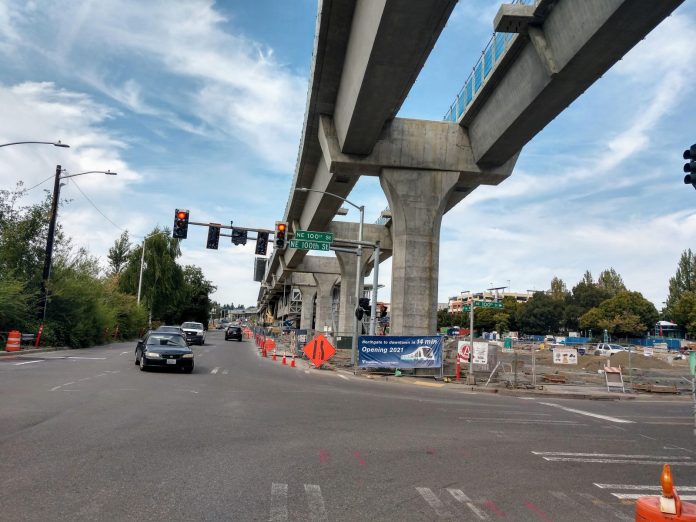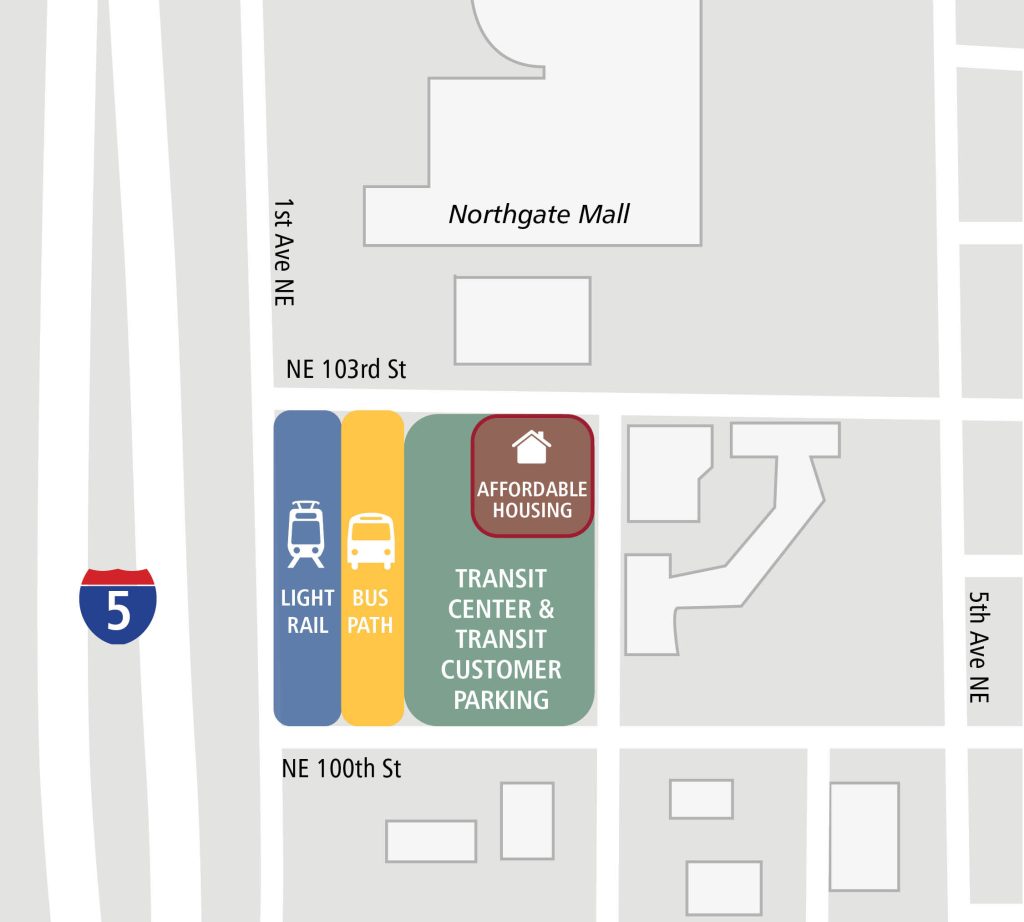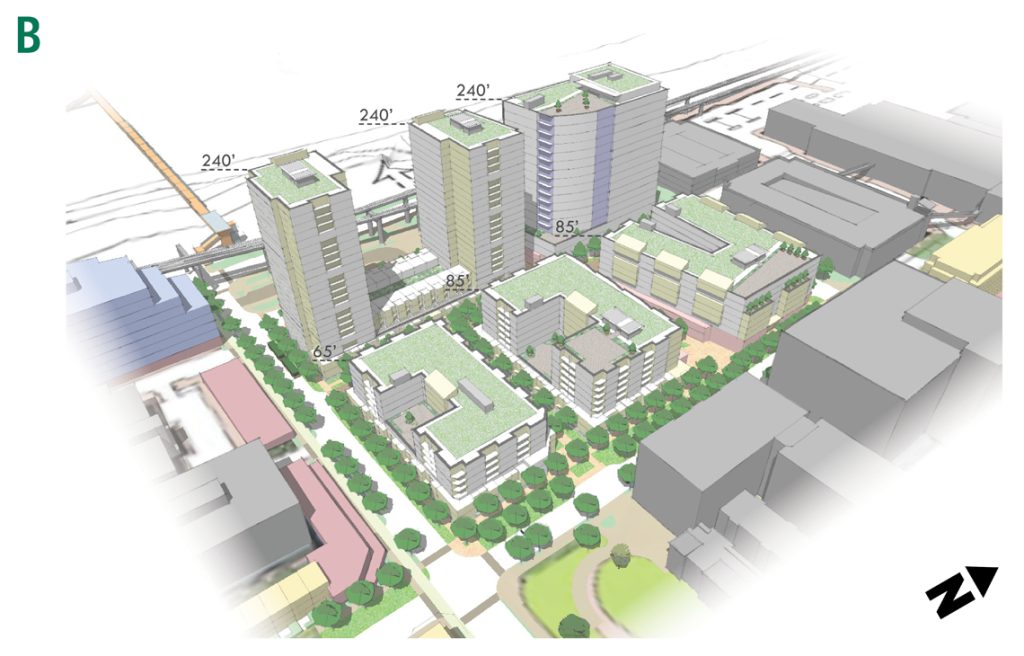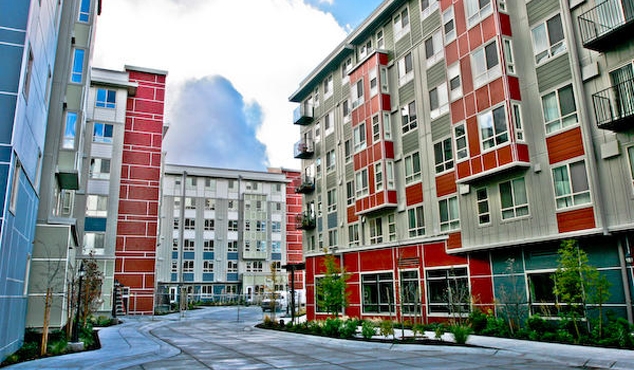
In the midst of a regional housing crunch and global climate emergency, a park-and-ride next to a soon-to-open light rail station is successfully clinging to life.
King County Metro announced Wednesday that plans to redevelop the Northgate park-and-ride would be put off until 2024 or later. The park-and-ride will continue to operate in the meantime, squandering a prime site for transit-oriented development (TOD) but providing a few motorists with the chance to park near a light rail station.
Previously, the County had sought to create 500 to 600 residences in Phase 1 via midrise development, with even more envisioned in Phase 2 thanks to highrise 240-foot zoning near the station. Phase 1 plans were scaled back and delayed, though.
King County did reach an agreement for an affordable-only development at the northeast corner of the site, which comprise about 20% of the megablock. BRIDGE Housing Corporation will build 232 homes affordable to households making 30% to 60% of area median income. Capitol Hill Housing will operate the site. The County is offering the land to the nonprofit developers via a zero-cost lease. Additionally, the County and the City of Seattle are each chipping in $10 million to help fund construction of the building.
“We’re proud that this partnership is creating new, affordable homes at a transit-rich site,” said Cynthia Parker, President and CEO of BRIDGE Housing, in a statement. “The 232 apartments will be affordable to people earning 30 to 60 percent of area median income–below $66,420 for a family of four. And the ground-floor child learning center will bring a much-needed service to residents and families throughout the neighborhood.”
BRIDGE expects to break ground in 2022, with the development agreement and ground lease to be transmitted to the King County Council by summer 2020. The project would also need to clear Seattle’s design review and permitting process.
The Northgate Link Extension is slated to open in 2021, adding three stations to Seattle’s light rail network. Northgate Station will be the northern terminus until the Lynnwood Link Extension opens in 2024–at which time King County Metro will restart the process to redevelop the remainder of the site.

King County Metro was already on its second Request for Proposals (RFP) when talks with the developer with the leading bid–Stellar Holdings, which also owns Thornton Place–broke down.
Back in June 2018, frustrations with the County’s handling of the Northgate TOD project were already boiling over for Councilmember Debora Juarez, who represents the Northgate neighborhood. She didn’t mince words in her comments to SCC Insight‘s Kevin Schofield.
“We still don’t have a timeline. It means denial for my community. It’s just going to sit there. All this momentum, energy, hours [of work] came to a halt when they reset the RFP,” Councilmember Juarez said at the time. “I’m disappointed that Northgate may become the textbook example of how not to do transit-oriented development. I thought we were going to be the shining example of how to do it.”

Safe to say further delay was not welcome news to Councilmember Juarez. Her office did not immediately reply to request for comment.
The silver lining could be that the delay could allow even more housing to go in when it finally is built. Passage of “citywide” Mandatory Housing Affordability upped the site to 240-foot zoning (with a 7.0 floor area ratio and a 9% affordability requirement). The City of Seattle could further upzone the site to maximize affordable housing development. Delay could also encourage developers to max out the capacity of the site, which is about 1.8 million square feet presently.
Northgate isn’t yet a proven market for highrise development, but it might be by 2024. Highrises might already be next door, making a 24-story, or even higher, less of a leap or a gamble for the builder who finally claims this long dangled prize.
Just to the north, the Northgate Mall is undergoing a major overhaul, but so far the mall’s landlord, Simon Properties, is emphasizing office space and NHL Seattle’s Practice Complex over housing. Even farther north, the Seattle Housing Authority recently purchased the 8.5-acre Northgate Commons to prevent displacement of residents there and allow for further expansion of affordable housing stock down the road. Until then, the move treads water in terms of total amount of housing.
Some housing development is taking place in Northgate, despite the delay at the signature site.

“Over the next five years, Metro has the opportunity to look at evolving service needs of the area and align it with plans for the [equitable transit-oriented development],” Metro wrote on its project website. “For now, the parcel will continue to serve as a park & ride.”
Arguably, the highest need of the Northgate community is affordable housing today and will likely continue to be in five years’ time. A park-and-ride, meanwhile, puts the needs of a few people outside the Northgate community ahead of those inside it. We have five years to think on that, whether we needed it or not.
And unless we increase the scope of the project (and the public benefits associated with it), we’ll end up exactly were we started.
Doug Trumm is publisher of The Urbanist. An Urbanist writer since 2015, he dreams of pedestrian streets, bus lanes, and a mass-timber building spree to end our housing crisis. He graduated from the Evans School of Public Policy and Governance at the University of Washington in 2019. He lives in Seattle's Fremont neighborhood and loves to explore the city by foot and by bike.

